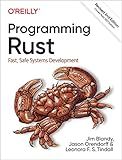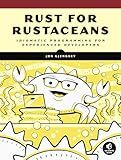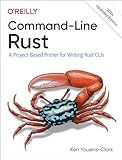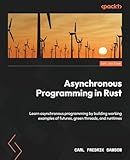Best Trait Bound Books in Rust to Buy in January 2026

The Rust Programming Language, 2nd Edition



Programming Rust: Fast, Safe Systems Development



Rust for Rustaceans: Idiomatic Programming for Experienced Developers



Rust in Action



Rust Programming: A Practical Guide to Fast, Efficient, and Safe Code with Ownership, Concurrency, and Web Programming (Rheinwerk Computing)



Rust Atomics and Locks: Low-Level Concurrency in Practice



Learn Rust in a Month of Lunches



Command-Line Rust: A Project-Based Primer for Writing Rust CLIs



Asynchronous Programming in Rust: Learn asynchronous programming by building working examples of futures, green threads, and runtimes


In Rust, trait bounds are used to specify constraints on generic types. This allows you to define functions or data structures that work with any type that implements a particular trait. To use a trait bound, you specify the trait name followed by the desired generic type in angle brackets after the function or data structure declaration.
For example, if you have a function that takes a generic type T that implements the Display trait, you can specify this constraint using a trait bound like so:
use std::fmt::Display;
fn display_value<T: Display>(value: T) { println!("{}", value); }
In this example, the display_value function can now only be called with a type that implements the Display trait. If you were to try to call display_value with a type that does not implement Display, the code would not compile.
Trait bounds can also be used with multiple traits or with where clauses to specify more complex constraints on generic types. Overall, trait bounds are a powerful feature in Rust that help ensure type safety and promote code reuse.
How to use trait bounds to ensure type safety in Rust?
Trait bounds are used in Rust to specify requirements on the types that can be used as generic parameters. They help ensure type safety by restricting the set of possible types that can be used with a generic function or struct to those that implement certain traits.
Here is an example of how trait bounds can be used to ensure type safety in Rust:
// Define a trait that specifies a method called 'print_info' trait Printable { fn print_info(&self); }
// Implement the 'Printable' trait for the 'Person' struct struct Person { name: String, age: u32, }
impl Printable for Person { fn print_info(&self) { println!("Name: {}, Age: {}", self.name, self.age); } }
// A generic function that takes a generic parameter 'T' with the trait bound 'Printable' fn print<T: Printable>(item: T) { item.print_info(); }
fn main() { let person = Person { name: String::from("Alice"), age: 30, };
print(person); // This will compile and run successfully
let num = 10;
// print(num); // This will result in a compile-time error because 'i32' does not implement the 'Printable' trait
}
In this example, the Printable trait specifies a method print_info, and the Person struct implements this trait. The print function takes a generic parameter T with the trait bound Printable, ensuring that only types that implement the Printable trait can be passed to this function. This helps ensure type safety by preventing the usage of types that do not satisfy the trait bounds.
Using trait bounds in this way ensures that only types that satisfy certain requirements can be used with generic functions or structs, helping to prevent type errors and improve code safety in Rust.
How to use trait bounds to achieve code reusability in Rust?
Trait bounds in Rust allow you to specify constraints on generic types, ensuring that they implement certain traits. This allows you to write more generic and reusable code while still enforcing certain behaviors.
Here's an example of how you can use trait bounds to achieve code reusability in Rust:
trait Printable { fn print(&self); }
struct Point { x: i32, y: i32, }
impl Printable for Point { fn print(&self) { println!("({}, {})", self.x, self.y); } }
fn print_points<T: Printable>(points: Vec) { for point in points { point.print(); } }
fn main() { let points = vec![ Point { x: 1, y: 2 }, Point { x: 3, y: 4 }, Point { x: 5, y: 6 }, ];
print\_points(points);
}
In this example, we define a Printable trait that defines a print method. We then implement this trait for the Point struct. We also define a print_points function that takes a vector of any type that implements Printable and calls the print method on each element in the vector.
By using trait bounds, we can ensure that only types that implement the Printable trait can be passed to the print_points function, ensuring that the behavior is consistent across different types.
This allows us to write more generic code that can be reused with different types, making our code more flexible and easier to maintain.
What is a trait bound in Rust?
A trait bound in Rust is a constraint that specifies that a certain type parameter must implement a particular trait in order to be used. This allows for generic functions and structs to be more flexible and ensure that the desired behavior is implemented for certain types. Trait bounds are specified using the syntax TraitName, where TraitName is the name of the trait that the type parameter must implement.
How to specialize trait bounds for specific use cases in Rust?
In Rust, trait bounds can be specialized for specific use cases by using conditional compilation, specialization, and associated types. Here are some techniques to specialize trait bounds for specific use cases in Rust:
- Conditional compilation: Use conditional compilation to define trait bounds for specific use cases. By using conditional compilation with #[cfg(...)] attributes, you can define trait bounds based on specific features or configurations. For example:
#[cfg(feature = "special_case")] impl<T: SpecialTrait> MyStruct { // Implementations for special case }
- Specialization: Use the default keyword in trait implementations to define generic implementations, and then specialize the trait for specific types or cases. This allows you to provide more specific implementations for certain cases while falling back to a generic implementation for others. For example:
trait MyTrait { fn foo(&self); }
default impl MyTrait for T { fn foo(&self) { // Generic implementation } }
impl MyTrait for SpecialType { fn foo(&self) { // Specialized implementation for SpecialType } }
- Associated types: Use associated types in trait definitions to allow trait implementors to define specific types for certain operations. By using associated types, you can define trait bounds that are specific to the associated type. For example:
trait Container { type Item;
fn get\_item(&self) -> &Self::Item;
}
impl Container for Vec { type Item = i32;
fn get\_item(&self) -> &i32 {
&self\[0\]
}
}
By using these techniques, you can specialize trait bounds for specific use cases in Rust, making your code more flexible and adaptable to different scenarios.
